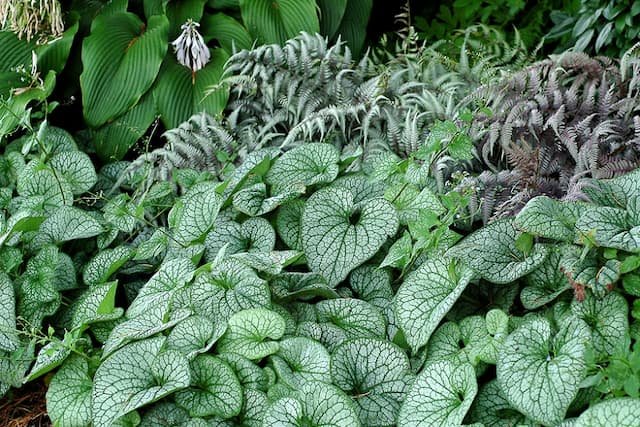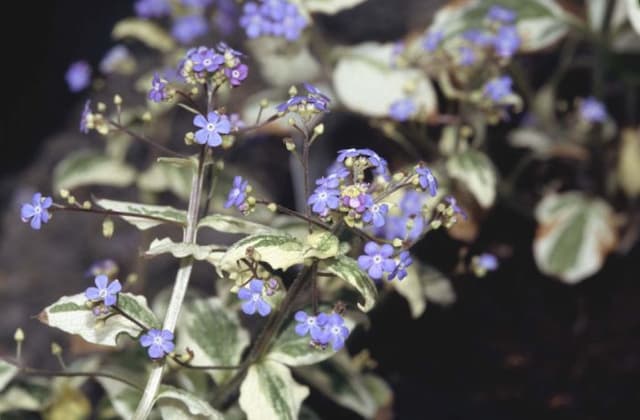Lungwort Pulmonaria longifolia

ABOUT
The plant commonly known as Lungwort is a perennial herb distinguished by its hairy, lance-shaped leaves that often have a speckled or mottled pattern of white spots. These distinctive spots are reminiscent of lung tissue, hence the name. The leaves form a low-growing clump and may vary in color from green to silver-gray. Lungwort produces clusters of small, funnel-shaped flowers that bloom in the spring. The flowers typically change color as they mature, starting out pinkish and then gradually shifting to a blue or violet hue. This chameleon-like trait is due to the pH changes in the flowers' cell sap as they age. The plant's delicate beauty and unique leaf patterns make it a charming addition to shade gardens or woodland settings.
About this plant
 Names
NamesSynonyms
Long-Leafed Lungwort, Narrow-Leaved Lungwort
Common names
Pulmonaria azurea, Pulmonaria saccharata, Pulmonaria vallarsae.
 Toxicity
ToxicityTo humans
Lungwort (Pulmonaria longifolia) is generally not considered toxic to humans. There is limited information on serious adverse effects from ingesting lungwort, and it has been used historically in herbal medicine. However, as with any plant not commonly consumed, individual allergies or reactions cannot be ruled out, so it's best to exercise caution and avoid ingesting it unless it is known to be safe for consumption.
To pets
Lungwort (Pulmonaria longifolia) is not known to be toxic to pets such as dogs and cats. There is no widespread documentation of poisoning or harmful effects from pets ingesting lungwort. Nonetheless, to prevent any potential issues, it's still a good practice to monitor your pets around plants and discourage them from chewing on plants not intended for consumption.
 Characteristics
CharacteristicsLife cycle
Perennials
Foliage type
Semi-deciduous
Color of leaves
Varies
Flower color
Mixed
Height
1 foot (30 cm)
Spread
2 feet (60 cm)
Plant type
Herb
Hardiness zones
4
Native area
Europe
Benefits
 General Benefits
General Benefits- Attracts pollinators: Pulmonaria longifolia is known for its ability to attract bees, butterflies, and other pollinating insects, which is beneficial for the garden ecosystem.
- Aesthetic appeal: With its unique spotted leaves and colorful flowers that shift from pink to blue as they age, Lungwort adds beauty and interest to shade gardens.
- Tolerance of shade: As a woodland plant, Lungwort is well adapted to growing in shady conditions where other plants might struggle.
- Ground cover: With its low-growing, spreading nature, Lungwort makes an excellent ground cover that can help suppress weeds and reduce soil erosion.
- Hardiness: Lungwort is a hardy perennial, capable of surviving in climates with cold winters, making it a reliable choice for gardeners in many regions.
- Seasonal interest: Lungwort offers early spring blooms, which can be one of the first sources of nectar for insects after the winter.
- Low maintenance: Once established, Lungwort generally requires minimal care beyond occasional watering and the removal of dead leaves or flowers.
- Diversity in garden design: The plant's varied leaf patterns and flower colors provide options for gardeners looking to create a diverse and textured shade garden.
- Resistant to deer and other pests: Lungwort is known for being resistant to deer, which makes it a suitable choice for gardens in areas with large deer populations.
 Medical Properties
Medical PropertiesThis plant is not used for medical purposes.
 Air-purifying Qualities
Air-purifying QualitiesThis plant is not specifically known for air purifying qualities.
 Other Uses
Other Uses- Pulmonaria longifolia, commonly known as lungwort, can be used as a natural dye, providing a variety of colors from its leaves and flowers depending on the mordant used.
- The leaves of lungwort can be added to compost heaps as they are rich in nitrogen and other minerals, which help in speeding up the composting process.
- Lungwort can be used as an indicator plant in a garden because it thrives in rich, moist soil with good shade, signaling a suitable environment for other shade-loving plants.
- The plant is sometimes used in permaculture as ground cover to maintain soil moisture and suppress weeds with its dense foliage.
- In the past, the patterned leaves of lungwort have been used for decorative purposes in 'nature printing,' a process where plants are pressed onto surfaces to create patterns.
- Lungwort can be incorporated into green roofs for its low-maintenance characteristics and tolerance to partial shade, contributing to biodiversity in urban environments.
- The flowers of lungwort are edible and can be used as a colorful garnish in salads, bringing a subtle sweetness to dishes.
- Gardeners might use dried lungwort leaves as a natural mulch to enrich soil and protect plant roots due to their high nutrient content.
- Lungwort's early spring flowers provide vital nectar for pollinators like bees when few other food sources are available.
- Artists have utilized lungwort by pressing its attractive leaves into clay to create natural patterns in ceramics and pottery work.
Interesting Facts
 Feng Shui
Feng ShuiLungwort is not used in Feng Shui practice.
 Zodiac Sign Compitability
Zodiac Sign CompitabilityLungwort is not used in astrology practice.
 Plant Symbolism
Plant Symbolism- Medicinal Symbolism: Also known as Lungwort, the plant was historically used in folk medicine, particularly for lung diseases, reflecting the belief in the Doctrine of Signatures where the plant's lung-shaped leaves symbolized a remedy for lung ailments.
- Perseverance: As an early spring bloomer that can thrive in shady areas, Lungwort symbolizes resilience and the ability to overcome challenges in unfavorable conditions.
- Hope: Its early appearance in the year can represent hope and the promise of renewal, often being one of the first signs of spring returning.
 Water
WaterThe Pulmonaria, commonly known as Lungwort, should be watered deeply once a week, ensuring that the soil is thoroughly moistened. Lungwort prefers consistently moist but not waterlogged soil, so be careful to avoid overwatering. During hot or dry weather, it may require additional water, potentially increasing frequency to twice a week. On average, you should provide 1 to 1.5 gallons of water per plant for each watering session, ensuring you're reaching the root zone each time. It is important to water the base rather than the leaves to avoid foliar diseases.
 Light
LightLungwort thrives best in partial to full shade, which protects it from the harsh midday sun. It can tolerate morning sunlight but should be placed in a location where it will be shielded from intense afternoon rays. An ideal spot for Lungwort would be under a canopy of deciduous trees, where it can receive dappled light.
 Temperature
TemperatureLungwort performs well in a temperature range between 50°F and 75°F. It can survive a minimum temperature down to 20°F and should be protected from extreme cold. Ideal conditions involve cool to moderate temperatures, as too much heat can cause Lungwort to go dormant or suffer stress.
 Pruning
PruningLungwort should be pruned to remove any dead or damaged leaves and to maintain its appearance. Pruning is best done in the late spring, after flowering, to allow for new growth. It is not necessary to prune Lungwort frequently; doing so once a season is typically enough.
 Cleaning
CleaningAs needed
 Soil
SoilLungwort (Pulmonaria longifolia) thrives in a soil mix that is rich in organic matter, moist, and well-draining. A good mixture might consist of garden soil, compost, leaf mold, and perlite to improve drainage. Aim for a soil pH of about 4.5 to 7.5, slightly acidic to neutral.
 Repotting
RepottingLungwort typically does not need frequent repotting and can thrive in the same container for several years. However, consider repotting every 3-4 years or when it outgrows its current pot.
 Humidity & Misting
Humidity & MistingLungwort prefers high humidity levels but is quite adaptable. Average room humidity should be satisfactory, but if the air is very dry, especially during winter, a humidifier or occasional misting can help.
 Suitable locations
Suitable locationsIndoor
Place lungwort in bright, indirect light and ensure high humidity.
Outdoor
Plant in part-shade, moist soil, protect from hot afternoon sun.
Hardiness zone
4-8 USDA
 Life cycle
Life cyclePulmonaria longifolia, commonly known as Lungwort, begins its life cycle when seeds are dispersed from mature plants, often in late spring or summer. These seeds germinate, typically in cool, shady conditions, producing small rosettes of basal leaves. Over time, these rosettes develop into larger clumps with their distinctive long, narrow leaves that are often spotted or mottled. In early to late spring, the plant enters its flowering stage, producing clusters of flowers that change color from pink to blue as they mature, which is indicative of the presence of pH-sensitive anthocyanins in the petals. After pollination, often by bees, the flowers develop into small seed capsules that release new seeds to complete the cycle. During winter, Lungwort may become dormant, but is capable of surviving cold season with its roots intact, ready to regenerate in the following spring.
 Propogation
PropogationPropogation time
Spring to Summer
Pulmonaria longifolia, commonly known as Lungwort, is most commonly propagated by division. The best time to divide this plant is in the spring or just after flowering to allow time for the plant to establish in its new location before the onset of winter. To propagate Lungwort by division, carefully dig up the plant and gently separate it into smaller clumps, ensuring that each section has a portion of the root system. Replant the divisions immediately at the same soil depth they were previously grown, spacing them about 12 inches (approximately 30 centimeters) apart to allow for adequate growth. Water the transplants thoroughly. This method encourages a high success rate as it allows each division to quickly establish a strong root system.









